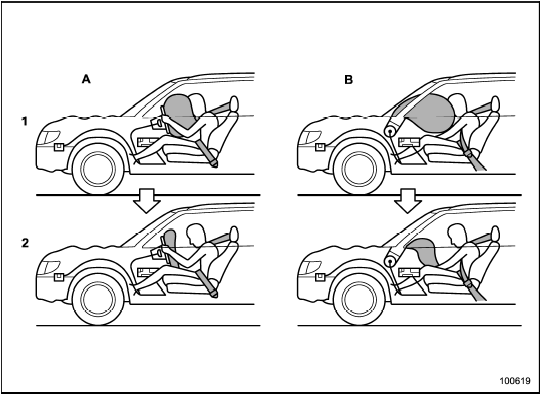 Subaru Forester: Operation
Subaru Forester: Operation

A) Driver’s side
B) Passenger’s side
1) SRS AIRBAGs deploy as soon as a collision occurs
2) After deployment, SRS AIRBAGs start to deflate immediately so that the
driver’s vision is not
obstructed.
The SRS airbag can function only when the ignition switch is in the “ON” position.
The SUBARU advanced frontal airbag system is designed to determine the activation or deactivation condition of the front passenger’s SRS frontal airbag depending on the total load on the front passenger’s seat monitored by the front passenger’s occupant detection system weight sensor. For this reason, only the driver’s SRS frontal airbag may deploy in the event of a collision, but this does not mean failure of the system.
If the front sub sensors and the impact sensors in the airbag control module detect a predetermined amount of force during a frontal collision, the control module sends signals to the airbag module(s) (only driver’s module or both driver’s and front passenger’s modules) instructing the module(s) to inflate the SRS frontal airbag(s). The driver’s and front passenger’s SRS frontal airbags use dual stage inflators.
The two inflators of each airbag are triggered either sequentially or simultaneously, depending on the severity of impact, in the case of the driver’s SRS frontal airbag and depending on the severity of impact and the total load on the seat in the case of the front passenger’s SRS frontal airbag. After deployment, the SRS airbag immediately starts to deflate so that the driver’s vision is not obstructed. The time required from detecting impact to the deflation of the SRS airbag after deployment is shorter than the blink of an eye.
Both when only the driver’s SRS frontal airbag deploys and the driver’s and front passenger’s SRS frontal airbags deploy, the driver’s and front passenger’s seatbelt pretensioners operate at the same time.
Although it is highly unlikely that the SRS airbag would activate in a non-accident situation, should it occur, the SRS airbag will deflate quickly, not obscuring vision and will not interfere with the driver’s ability to maintain control of the vehicle.
When the SRS airbag deploys, a sudden, fairly loud inflation noise will be heard and some smoke will be released. These occurrences are a normal result of the deployment. This smoke does not indicate a fire in the vehicle.

Do not touch the SRS airbag system components around the steering wheel and dashboard with bare hands right after deployment. Doing so can cause burns because the components can be very hot as a result of deployment.
The driver’s SRS frontal airbag and front passenger’s SRS frontal airbag are designed to deploy in the event of an accident involving a moderate to severe frontal collision. It is basically not designed to deploy in lesser frontal impacts because the necessary protection can be achieved by the seatbelt alone. Also, they are basically not designed to deploy in side or rear impacts or in roll-over accidents because deployment of only the driver’s SRS frontal airbag or both driver’s and front passenger’s SRS frontal airbags would not help the occupant in those situations. The driver’s and front passenger’s SRS frontal airbags are designed to function on a one-time-only basis.
SRS airbag deployment depends on the level of force experienced in the passenger compartment during a collision. That level differs from one type of collision to another, and it may have no bearing on the visible damage done to the vehicle itself.
 Effect vehicle modifications made for persons with disabilities may have on
SUBARU advanced frontal airbag system operation (U.S. only)
Effect vehicle modifications made for persons with disabilities may have on
SUBARU advanced frontal airbag system operation (U.S. only)
Changing or moving any parts of the front
seats, rear seat, seatbelts, front bumper,
front side frame, radiator panel, instrument
panel, combination meter, steering wheel,
steering column, tir ...
 Example of accident in which the driver’s/driver’s and front passenger’s SRS
frontal airbag(s) will most likely deploy.
Example of accident in which the driver’s/driver’s and front passenger’s SRS
frontal airbag(s) will most likely deploy.
A head-on collision against a thick concrete
wall at a vehicle speed of 12 to 19
mph (20 to 30 km/h) or higher activates
only the driver’s SRS frontal airbag or both
driver’s and front p ...
See also:
Switching the windshield wipers on/ off
WARNING
Wiper blades are components that are subject to wear and tear. Replace the wiper
blades twice a year, preferably in the spring and fall. Otherwise the windows will
not be wiped prope ...
Removing a PC Card
To remove a PC card from the audio
unit, fold back the screen by
pressing the OPEN button. Press the eject button (
)
to remove the card. If you do not
remove it from the slot, you cannot
...
Luggage Compartment Light
Luggage Compartment
Light
The luggage compartment light is located at the left side of the rear luggage
compartment. When you open any of the doors including the tailgate with the luggage
comp ...
